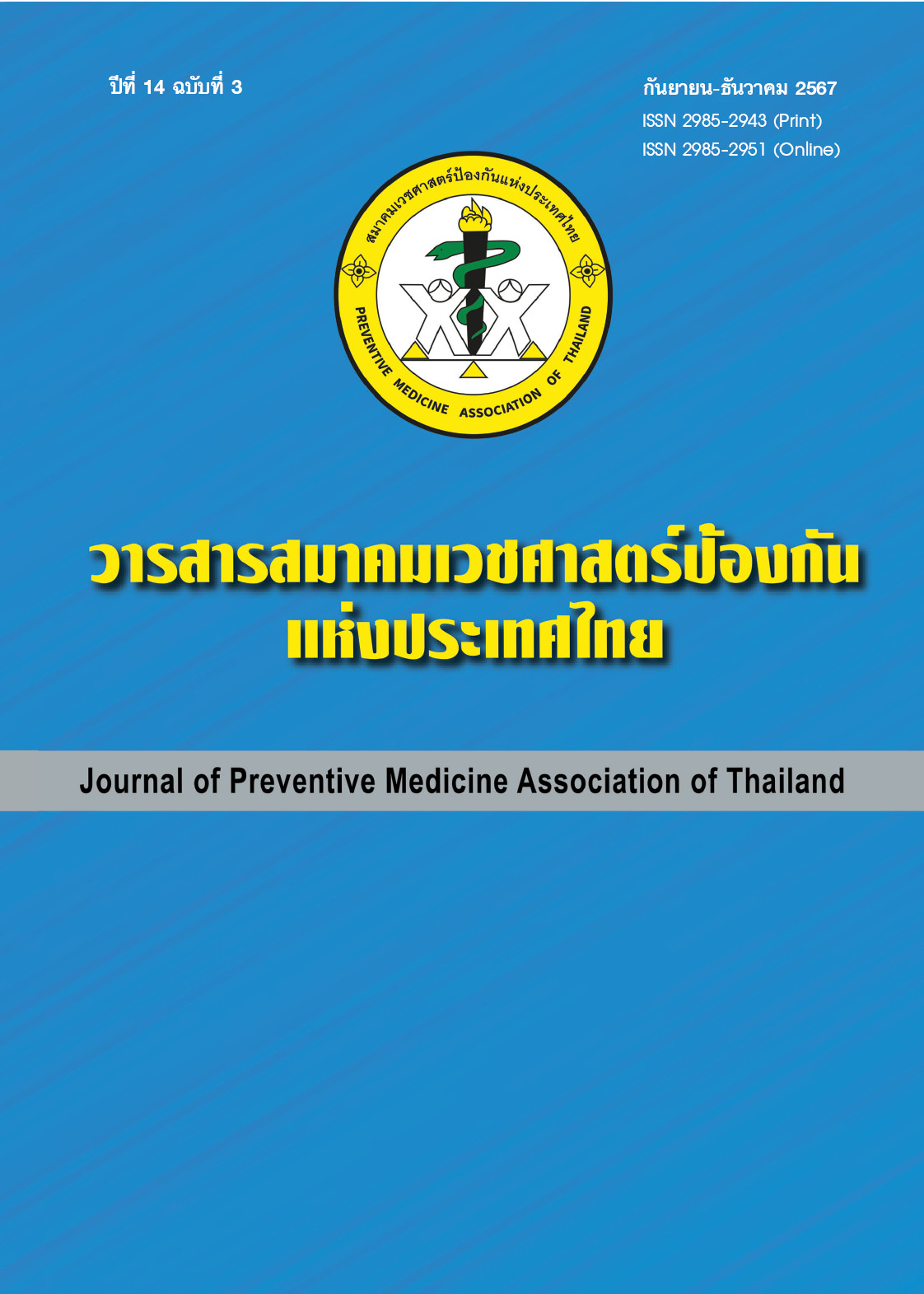Accuracy of Neck Circumference in Predicting the Severity of Obstructive Sleep Apnea at Pranangklao Hospital
Abstract
Background: Obesity is associated with the occurrence of obstructive sleep apnea (OSA) and neck fat. The diagnosis of OSA, typically uses the body mass index (BMI), which reflects overall fat distribution but not specifically indicate neck fat. Neck circumference can be inferred as an indicator of fat distribution and body shape within the population. Objective: This study aims to investigate the relationship between neck circumference and the severity of OSA, as well as to determine the appropriate cutoff point for neck circumference in predicting the severity of OSA at Pranangklao Hospital. Methods: This retrospective study included patients diagnosed with OSA between January 2021 and April 2024, totaling 64 cases. Data were collected using created record form. Relationships were analyzed using Chi-square or Fisher's exact test for categorical variables and one-way ANOVA for continuous variables. The appropriate cutoff point for neck circumference was determined using diagnostic tests, displaying sensitivity, specificity and the area under the receiver operating characteristic curve (AUROC). Results: Among the 64 patients diagnosed with OSA between January 2021 and April 2024, there were 13 cases (20.32%) with mild severity, 14 cases (21.87%) with moderate severity, and 37 cases (57.81%) with severe OSA. The analysis using one-way ANOVA revealed that neck circumference was significantly associated with the severity of OSA (p<0.01). For moderate OSA patients, the cutoff point for neck circumference was 37.5 cm, with a sensitivity of 73%, specificity of 85%, and ROC of 79%. For severe OSA patients, the cutoff point was 38.5 cm, with a sensitivity of 73%, specificity of 74%, and ROC of 74%. Conclusion: Neck circumference is associated with the severity of obstructive sleep apnea (OSA). It is necessary to redefine the appropriate neck circumference for predicting OSA severity specifically for the Thai population. Identifying an optimal neck circumference cutoff point for predicting OSA severity in the Thai population is highly beneficial, as an accurate cutoff point can significantly aid in the diagnosis and treatment of OSA. Therefore, analyzing and developing appropriate OSA screening tools for the Thai population is crucial for effective health care and disease prevention in Thailand.
References
Slowik JM, Sankari A, Collen JF. Obstructive Sleep Apnea. Treasure Island (FL): StatPearls Publishing; 2024.
Lévy P, Kohler M, McNicholas WT, Barbé F, McEvoy RD, Somers VK, et al. Obstructive sleep apnoea syndrome. Nat Rev Dis Primers 2015;1(1):15015.
Esteller E, Carrasco M, Díaz-Herrera MÁ, Vila J, Sampol G, Juvanteny J, et al. Clinical practice guideline recommendations on examination of the upper airway for adults with suspected obstructive sleep apnoea-hypopnoea syndrome. Acta Otorrinolaringol Esp 2019;70(6):364–72.
สมาคมโรคจากการหลับแห่งประเทศไทย. ภาวะหยุดหายใจขณะหลับจากการอุดกั้นในประเทศไทย สำหรับผู้ใหญ่ พ.ศ. 2561. กรุงเทพฯ: สมาคมโรคจากการหลับแห่งประเทศไทย; 2561.
Senaratna CV, Perret JL, Lodge CJ, Lowe AJ, Campbell BE, Matheson MC, et al. Prevalence of obstructive sleep apnea in the general population: a systematic review. Sleep Med Rev 2017;34:70–81.
Malhotra RK, Kirsch DB, Kristo DA, Olson EJ, Aurora RN, Carden KA, et al. Polysomnography for obstructive sleep apnea should include arousal-based scoring: An American academy of sleep medicine position statement. J Clin Sleep Med 2018;14(7):1245–7.
Masa JF, Corral J, Sanchez de Cos J, Duran-Cantolla J, Cabello M, Hernández-Blasco L, et al. Effectiveness of three sleep apnea management alternatives. Sleep 2013;36(12):1799–807.
Duarte RLM, Magalhães-da-Silveira FJ, Gozal D. Prediction of obstructive sleep apnea using GOAL questionnaire in adults with or without excessive daytime sleepiness: a cross-sectional study. Sleep Health 2021;7(2):212–8.
Chiu HY, Chen PY, Chuang LP, Chen NH, Tu YK, Hsieh YJ, et al. Diagnostic accuracy of the Berlin questionnaire, STOP-BANG, STOP, and Epworth sleepiness scale in detecting obstructive sleep apnea: a bivariate meta-analysis. Sleep Med Rev 2017;36:57–70.
Zhao Y, Yan X, Liang C, Wang L, Zhang H, Yu H. Incorporating neck circumference or neck-to-height ratio into the GOAL questionnaire to better detect and describe obstructive sleep apnea with application to clinical decisions. Frontiers in Neuroscience 2022;16:1-10.
Gasa M, López-Padrós C, Monasterio C, Salord N, Mayos M, Vilarrasa N, et al. Anthropometrical phenotypes are important when explaining obstructive sleep apnea in female bariatric cohorts. J Sleep Res 2019;28(5):e12830.
Ryan AS, Elahi D. Hydrodensitometry: Encyclopedia of Gerontology. 2nd ed. San Diego: Academic Press; 2007.
Fattal D, Hester S, Wendt L. Body weight and obstructive sleep apnea: a mathematical relationship between body mass index and apnea-hypopnea index in veterans. J Clin Sleep Med 18(12):2723–9.
Loh JMR, Toh ST. Rethinking neck circumference in STOP-BANG for Asian OSA. Proc Singap Healthc 2019;28(2):105–9.
Carvalho WRC, França AKT da C, Santos AMD, Padilha LL, Bogea EG. Appropriate neck circumference and waist-to-height ratio cut-off points as predictors of obesity and cardiovascular risk in adolescents. Rev Saúde Pública 2023;57(24):1-14.
Kirsch DB. Obstructive Sleep Apnea. Continuum (Minneap Minn) 2020;26(4):908–28.
Soylu AC, Levent E, Sarıman N, Yurtlu S, Alparslan S, Saygı A. Obstructive sleep apnea syndrome and anthropometric obesity indexes. Sleep Breath 2012;16(4):1151–8.
Wongpradit W, Kulalert P, Sattaratpaijit N. Factor associated with severity of obstructive sleep apnea in Thammasat University hospital. AMJAM 2023;23(2):110–7.
Irman S, Mohamad H, Amran M, Mohamad I. Association between neck circumference and the severity of obstructive sleep apnea. Pol Ann Med 2020;27(1):1-6.
Kim SE, Park BS, Park SH, Shin KJ, Ha SY, Park J, et al. Predictors for Presence and Severity of Obstructive Sleep Apnea in Snoring Patients: Significance of Neck Circumference. J Sleep Med 2015;12(2):34–8.
Garzon SBA, Muñoz-Velandia OM, Ruiz AJ, Martínez PH, Otero L. Cut-off points of neck and waist circumference as predictors of obstructive sleep apnea in the Colombian population: A comparison with polysomnography. São Paulo Med J 142(3):e2022415.
Rhee SC. Differences between Caucasian and Asian attractive faces. Skin Res Technol 2018;24(1):73–9.
Downloads
Published
How to Cite
Issue
Section
License
Copyright (c) 2024 สมาคมเวชศาสตร์ป้องกันแห่งประเทศไทย

This work is licensed under a Creative Commons Attribution-NonCommercial-NoDerivatives 4.0 International License.
บทความที่ลงพิมพ์ในวารสารเวชศาสตร์ป้องกันแห่งประเทศไทย ถือเป็นผลงานวิชาการ งานวิจัย วิเคราะห์ วิจารณ์ เป็นความเห็นส่วนตัวของผู้นิพนธ์ กองบรรณาธิการไม่จำเป็นต้องเห็นด้วยเสมอไปและผู้นิพนธ์จะต้องรับผิดชอบต่อบทความของตนเอง






